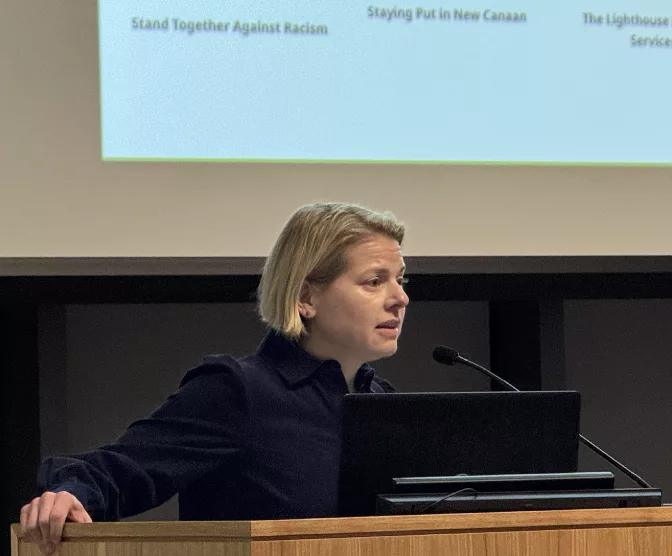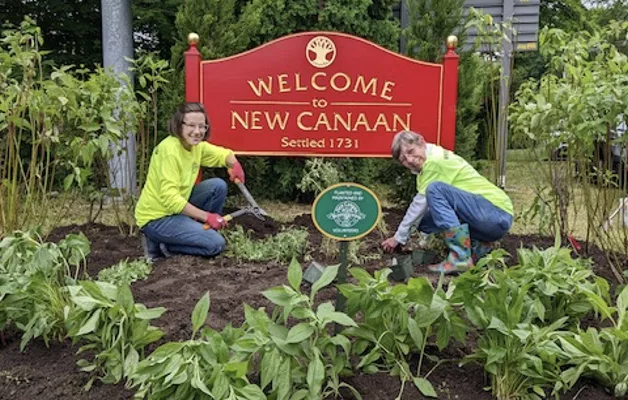
By John Kriz
The Community Health & Well-Being Survey results – an initial effort to better understand the current state of behavioral health in New Canaan, and residents’ understanding of and access to supportive resources — were shared with the New Canaan community on Monday, January 27, in New Canaan Library’s Bartlett Auditorium, with numerous community leaders speaking.
The key takeaways are that while most people in town are doing well, many are not – especially parents and other caregivers, those worried about their own mental health, or who have low life satisfaction or low financial security. In a word: Stress. When you have the phrase “Parenting may be hazardous to your health” on a presentation slide, you know it just got very real.
While numerous supportive resources are available in New Canaan, including the Urgent Assessment Program www.newcanaan.info/_T8_R433.php run by the town in partnership with Silver Hill Hospital, many survey respondents were unaware that such resources were available at all. Beyond that challenge, assuming the person in need is aware of available resources, trying to sort out just where to begin, let alone manage cost and insurance, was a steep mountain for many to climb.
This survey, funded by the Town of New Canaan and completed by nearly 1500 residents, was the brainchild of the New Canaan Behavioral Health Alliance (www.newcanaanbha.org), which was formed several years ago by concerned local charities and community leaders with a goal of encouraging, developing and supporting “a greater community awareness of behavioral health issues and resources in our area. Through community partnering, the alliance’s mission is to improve access to behavioral health care for New Canaan residents seeking help.” Nearly forty regional and local groups are part of the NCBHA, including the New Canaan Public Schools, New Canaan Library, St. Luke’s School, Silver Hill Hospital, New Canaan Country School, the town’s Police, Fire, Parks & Recreation and Human Services departments, New Canaan EMS, New Canaan YMCA, New Canaan Parent Support Group, New Canaan Cares, New Canaan Community Foundation, Staying Put and Waveny Life Care.
A slide deck of the results, and full report, will be posted on the NCBHA’s website soon.
This survey, which was focused on adults, provides a baseline of data – a launching pad for follow-up surveys to generate longitudinal data, and test which solutions are working and which are not, as well as for more targeted surveys, such as one focused on the youth population.
Susannah Lewis, Director of Community Relations at Silver Hill Hospital, led off, noting the youth mental health crisis, and the stresses of parenting and loneliness – all exacerbated by COVID. Recent suicides in New Canaan have further focused the community’s attention on behavioral health. Said Ms. Lewis, “it was a good time to pause and say ‘How are we doing?’ ‘How do the residents of New Canaan feel like they’re doing?’ And ‘Do they have what they need to lead healthy, thriving lives?’” The survey became the starting point.
Lauren Patterson, president of New Canaan Community Foundation, and co-chair with Ms. Lewis and Marcella Rand of the town’s Human Services Department of the NCBHA, noted that, first, the town is “program and resource rich” but that “it’s a very hard system to navigate. Two, we have to do everything we can to reduce stigma and make it easier to talk about a whole variety of issues that fall under this [behavioral health] umbrella. And three, we really need local data.”
Key Findings
Groups of particular concern are people who are worried about their own mental health, have low life satisfaction, low financial security and are multiple caregivers (such as to both a child and an aging parent). These vulnerable groups report “much higher rates of not getting needed physical and mental health care,” per the presentation led by Nina Chanana of Chanana Consulting. While at least two-thirds of respondents did not report facing barriers to accessing physical and mental health services, the other third did. These barriers include getting an appointment, cost and insurance issues, and were higher for women than men, and for people from age 30 to 59. Also, people between 30 and 59 reported lower rates of well-being compared with older residents, and people between 40 and 59 reported the lowest rates of life satisfaction. “The Sandwich Generation is stressed out, low on money and short on time.”
The survey also found that many people in town are unaware of the resources that do exist. For example, 38%, 35% and 34% of respondents were not aware of available substance misuse, adult mental health and domestic violence community supports, respectively.
The survey results strongly indicated that it was easy for youths to access dangerous substances. For example, 95% of respondents said it was easy or very easy for children to access alcohol at home, with scores of 87% for tobacco, 79% for marijuana and 64% for prescription drugs.
Regarding family norms, most parents – with all scores being at least 90% – report strong family norms around monitoring, communication and modeling.
As to children’s mental health, 16% of parents reported that they believe their child has struggled with persistent anxiety during the past year, and 10% of parents reported that they believe their child has struggled with persistent depression during the past year. For both results, percentages rose with the age of the child. As well, 33% of parents did not know, or were unsure, where to get help if their child is struggling with mental health issues. Sixty percent of respondents to the survey had at least one child living at home.
On the brighter side, community support for prevention is strong, with 93% of respondents viewing prevention programs as a good community investment, and 84% believing they help reduce substance use problems.
Leaders Speak
Dr. Andrew Gerber, president of Silver Hill Hospital, noted that “the founders of the hospital believed in the notion of community mental health. That was a founding principle,” and that “we have to talk about it [behavioral health]. We have to have it part of our daily conversation.” However, even if you have the finest therapists and facilities, it’s all for naught “if you can’t reach the people who are struggling, if the individuals who have the problems and their families are either afraid or don’t know how to step up, raise their hands and access that care.” Dr. Gerber cited the one-third of people who had trouble accessing services, saying “we need to figure out what it is that’s keeping them from accessing those services.”
A key challenge seems to be about how best to get the word out. “We have great marketers in this town. We have great people who can teach us how to do that,” says Dr. Gerber. “And I think there’s more to be done there and it doesn’t have to cost a lot to do that. But I also think we have to learn in more detail what is it that’s keeping people from coming.”
New Canaan Public Schools superintendent Dr. Bryan Luizzi said that “mental health really has taken that top tier of concern,” and that socialization isn’t what it was a few years ago. “Kids aren’t going out as often as they used to. School dances aren’t as attended as they used to be.”
Much of this speaks to the value of emotional intelligence. Dr. Luizzi noted training programs at NCPS involving a wide range of staff to strengthen their emotional intelligence. “We did that because we wanted to make sure that our schools were welcoming places everywhere kids went.”
Furthermore, technology and social media use are important concerns of parents, and NCPS is “looking at systems to help empower students to become in charge of their relationships with their personal technology, instead of vice versa.” At Saxe Middle School there is a phone-free policy during the school day. “And we’ve seen a difference.”
“It’s about empowerment. Empowering them [students] to make the right choices, empowering them to know they’re the ones in charge of the decisions that they make.”
Colleen Prostor, executive director of New Canaan Cares, noted that many private and government grants require data, such as that created by this survey, as a prerequisite to a funding application. She noted that neighboring towns, such as Darien and Greenwich, have received large grants based in part on needs surveys they’ve done.
Leo Karl, who is on the Behavioral Health Committee of the New Canaan Community Foundation, concluded by noting that he knows of “really good New Canaan families, great parents that have not always had the smoothest road and the most fortune bringing up kids. And these issues pop up and you read about or hear about their story and you say, ‘Why didn’t I know about that?’ Or ‘Why couldn’t the community have done something?’” It is hoped that this survey, and the actions that will follow, will help address those questions.
Need Help Now?
During a post-presentation interview with the New Canaan Sentinel, Lauren Patterson of the New Canaan Community Foundation said “We want people to talk directly to a human being. We don’t want them to Google search or rely on maybe getting good information.” For those in need of truly immediate assistance, call 911 for a medical, fire, police or other emergency, or 988 for those who are suicidal or in emotional distress.
In addition, she strongly recommends accessing the Urgent Assessment Program run by the town and Silver Hill Hospital as a starting point. And one does not need to be in urgent distress to do so. In fact, early intervention is strongly recommended. “You’ll be seen within 24 to 48 hours for an assessment on campus and then they make a referral to a provider that’s already vetted to match your particular needs, the insurance that you might have. They have availability. So we’re not sending someone into a potential bottleneck or waitlist. We know this provider is available and waiting for that person call.”
Similar to the Urgent Assessment Program is Resources to Recover (www.rtor.org), which is an email and telephone line that’s run out of Laurel House, a nonprofit in Stamford that’s a referral service. “But again, you’re getting a human being on the phone or via email. There’s a direct person you’re talking with.”
All of these resources can be found on the Behavioral Health Alliance’s website www.newcanaanbha.org
What’s Next?
According to Ms. Patterson, immediate next steps include reviewing the exit surveys from the Monday presentation, and further outreach to the community on the survey’s findings to better understand the responses, and hear directly what would be most useful to address the needs. “We really want to hear from the community as to where the resources would be best placed. I think there are some lower hanging fruits, if you will, around outreach.” As well, she wishes “we could relieve that access issue. It’s not going to fix everything, but it is going to help more people.”
As to other ‘To Do’ items, a youth survey “is at the top of the list.” The Behavioral Health Alliance is “in active conversation with the public and private schools in town about what that could look like.” A follow-up adult survey is also likely, to “see if we’re making progress where we’ve made investments, where we’ve made adjustments to programs and outreach.”
Developing a better understanding of the barriers to both mental and physical health care is also in the cards. “The good news was most people were accessing care, but I think in a town like New Canaan we’d want to say there could be a gold standard that our town is as healthy as they want to be.”
Another item is to help regional service providers “tailor some of their regional work to what would really work for this particular town. And maybe it’s things that they know, but now we have the data to really help them make some change internally or we can help them.”
Ms. Patterson emphasizes that “it would be ideal to have a punch list. We’re going to do things one to three, but I think we want to be careful about not overreaching and over-assuming what would be the right next step.” She also stresses that “we want this to be actionable. We don’t want this to be a survey just for the sake of a survey and that it’s a great report and it sits on a shelf.” She concludes that “we want to build in enough of a pause to allow people to plan and react.”
Behold, I will bring it health and cure, and I will cure them, and will reveal unto them the abundance of peace and truth.
Jeremiah 33:6
John J Kriz is a 30+ year resident of New Canaan. The opinions expressed are his own.


